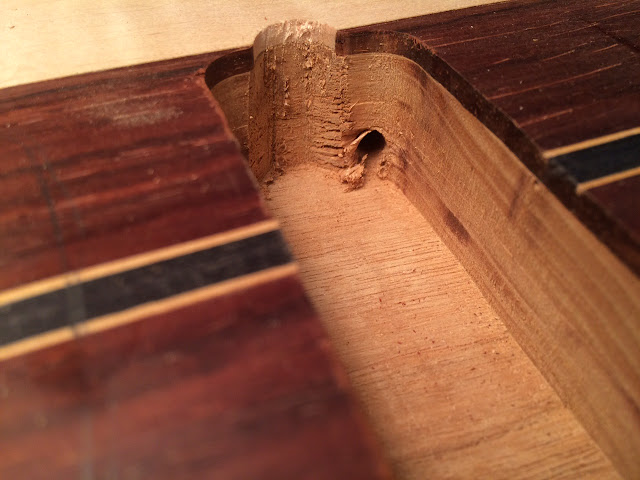 |
| That'll buff right out... |
Now that the body has most of the holes routed/drilled it's time to start fixing my earlier mistakes.
When I left off with this build (seven years ago!) the binding was incomplete and in the intervening years it has developed a few additional - oh let's call them "issues."
 |
| Looks fine (if you turn your head and squint a bit). |
A piece fell off around the smaller horn (and that broken piece is long gone), a couple of cracks have been there all along, a section came unglued, and I never did the bend around the bigger horn properly in the first place. So! There's much to do.
 |
| Don't be so picky. |
 |
| The answer to all my problems. |
This binding (unlike the plastic binding I used on the Les Paul build) is made of Cocobolo. A fabulous wood that is dense, oily, aromatic, and water resistant. If you have ever tried to bend wood before then you know water is usually an important part of the process. Not so much with Cocobolo. This stuff is so dense and oily it's one of the few wood types in the world that doesn't float. You pretty much just use heat to bend cocobolo. In this case - the same heat gun we used for the Les Paul binding.
 |
| Feelin' Hot, Hot, Hot! |
Also, because Cocobolo is so naturally oily you have to "degrease" it before you glue it. So keep some Acetone on hand prior to gluing. Wipe all of the cocobolo pieces down with a rag dipped in acetone. Again, this stuff isn't the best thing in the world for you (according to the State of California) - so don't bathe in it.
 |
| Look! I found my Special-purpose! |
I can't speak for other woods but with Cocobolo you really have to "listen" to the wood while you're bending it. I usually use a stethoscope...
 |
| I'm sure there is a joke in here somewhere about men "listening" so I'll just let you fill in the blanks. |
But seriously, as you apply the heat the wood will very quickly go from stiff to pliable. It's not a specific amount of time (or heat) but usually it's less than a minute of direct heat before it starts to bend. If you see the wood turning black or the wood resins bubbling you've gone too far - ease back on the heat. You want it JUST before that point.
The thing about heating and bending wood this way is that you really need a third hand. One hand to hold the heat gun, one hand to bend/reshape the wood and a third hand to tape it down.
 |
| A fourth hand to photograph it all wouldn't hurt either |
If you don't tape the binding down immediately - as it cools it will start to go back to it's original shape. It won't completely go back to it's original shape but you will lose a lot of those lovely curves you just created.
 |
| Quick tip: Don't use foil duct tape (or actual duct tape) like in the picture. Use low tack masking tape or painters tape. |
Like with plastic binding - you can use a bunch of different things to glue the binding down with. On this particular evening I used medium viscosity super glue. Since this is a wood binding being glued to a wood guitar body - you could use PVA (Wood) glue and it would give you more working time.
I wanted to scrape and sand the body in the same night as gluing the binding down - so I chose superglue. Also - it's supposed to work better with cocobolo. I'll let you know.
 |
| Remember to use just enough to glue your fingers together but not enough to glue what you actually wanted adhered. |
 |
| Mmmmm... Toasty |
Yeah, "Do as I say. Not as I do." This is a little cooked. I'm hopeful the charred parts will scrap off.
Patience is a virtue. Just not one of mine.
The glue on the above piece of binding has dried and this little section is ready to be cleaned up.
You use a similar process as you would for plastic binding: scrape the sides with a card scraper (or small plane) and sand smooth. One thing that is different about using cocobolo is that the oils can stain adjacent wood while you are sanding (which it did for me). I also used a utility razor blade as a card scraper as it is good for detail work.
 |
| Pictured: A lack of virtues |
 |
| Oh look! New problems. |
 |
| In process... |
...and I was starting to get sloppy - so I stopped for the night partway through the process.
I'll be honest - probably the most valuable lesson I've learned from building guitars is knowing when to just stop for the night and pick it up the next day.
There is more fiddly work to be done but this body is one step closer to being a guitar than it was yesterday.
 |
| Not quite there yet... |
Cocobolo is still one of my favorite woods to look at. Maybe not one of my favorites to make bindings from. But as it's the only wood binding I've tried so far - I have no basis for comparison.
Still, it cleans up real nice.
 |
| Getting purdy. |









